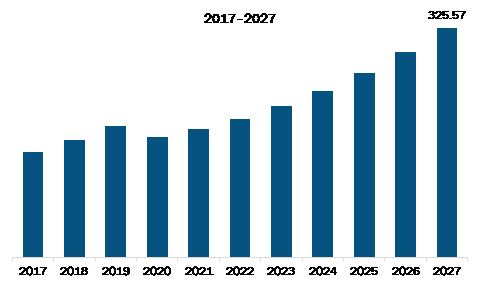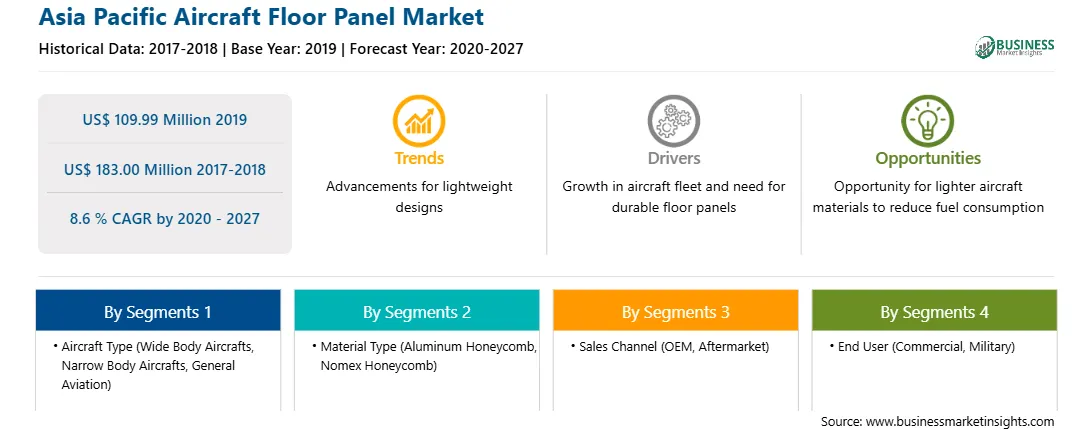The APAC aircraft manufacturing industry is witnessing significant growth due to the surging demand for passenger and military aircraft across APAC. The increasing disposable incomes and growing population in various countries across APAC region are some of the major factors driving the demand for various aircrafts types. The mounting demand for air travel across APAC region leads to the increased production of aircraft from manufacturers such as Boeing and Airbus. Aircraft floor panels are a critical component used in various types of aircraft, such as wide–body aircraft, narrow–body, and general aviation. This light-weight component has high durability and strength, which is ideal for aerospace applications. Based on the materials, several core materials, such as nomex and aluminum, are used in developing aerospace floor panels. The positive growth in the aircraft types is anticipated to fuel the demand for aircraft floor panel and offer future growth opportunities to market players operating in the APAC aircraft floor panel market. The technological developments and substantial investments in research and development by OEMs to manufacture aerospace structural parts are also anticipated to accelerate the market growth during the forecast period across APAC region. Factors such as upsurge in the adoption of wide body jets and business jets and rising demand for air freighter fleet are expected to drive the APAC aircraft floor panel market growth.
Furthermore, in case of COVID-19, APAC is highly affected specially the China and India. China is one of the leading aerospace manufacturing countries in the region and has been one of APAC's most affected country. Due to this, the manufacturing facilities have been witnessing severe conditions in aircraft and aircraft component manufacturing facilities. India, Japan, and South Korea are still combating the virus. However, the countries have eased the lockdown measures, which is reflecting the restart of manufacturing facilities. Nonetheless, the remarkable lower volumes of air travel passengers have slowed down the demand for various components among the OEMs and aftermarket players regionally and internationally. This has been negatively affecting the aircraft floor panels market. Several airlines in the region have retired their wide body jets and narrow body jets, which were prime customers of aftermarket products and services. This factor is anticipated to inhibit the aircraft floor panel market for the next few months.

Strategic insights for the Asia Pacific Aircraft Floor Panel provides data-driven analysis of the industry landscape, including current trends, key players, and regional nuances. These insights offer actionable recommendations, enabling readers to differentiate themselves from competitors by identifying untapped segments or developing unique value propositions. Leveraging data analytics, these insights help industry players anticipate the market shifts, whether investors, manufacturers, or other stakeholders. A future-oriented perspective is essential, helping stakeholders anticipate market shifts and position themselves for long-term success in this dynamic region. Ultimately, effective strategic insights empower readers to make informed decisions that drive profitability and achieve their business objectives within the market.

| Report Attribute | Details |
|---|---|
| Market size in 2019 | US$ 109.99 Million |
| Market Size by 2027 | US$ 183.00 Million |
| Global CAGR (2020 - 2027) | 8.6 % |
| Historical Data | 2017-2018 |
| Forecast period | 2020-2027 |
| Segments Covered |
By Aircraft Type
|
| Regions and Countries Covered | Asia-Pacific
|
| Market leaders and key company profiles |
The geographic scope of the Asia Pacific Aircraft Floor Panel refers to the specific areas in which a business operates and competes. Understanding local distinctions, such as diverse consumer preferences (e.g., demand for specific plug types or battery backup durations), varying economic conditions, and regulatory environments, is crucial for tailoring strategies to specific markets. Businesses can expand their reach by identifying underserved areas or adapting their offerings to meet local demands. A clear market focus allows for more effective resource allocation, targeted marketing campaigns, and better positioning against local competitors, ultimately driving growth in those targeted areas.

The APAC aircraft floor panel market is expected to grow from US$ 109.99 million in 2019 to US$ 183.00 million by 2027; it is estimated to grow at a CAGR of 8.6 % from 2020 to 2027. Noticeable aircraft orders and delivery volumes across APAC region is expected to accelerate the APAC aircraft floor panel market. The APAC aviation industry is undergoing expansion at a rapid pace, recording significant production volumes and deliveries of aircraft (commercial and military) fleet. Specifically, the commercial aviation industry has witnessed tremendous growth in the past few years with the emergence of new low cost carriers (LCCs) and fleet expansion strategies adopted by the full service carriers (FSCs). Further, commercial aviation is foreseen to surge in the coming years owing to the mounting number of air travel passengers and aircraft procurement. This surge in aircraft production is driving the aircraft floor panels market across APAC region. Owing to the continuously rising production volumes to bridge the gap between demand and supply of aircraft, the OEMs across APAC region are increasingly procuring large volumes of aircraft floor panels. In the current scenario, the demand for both wide body and narrow body aircraft fleet is high. However, the inclination toward long-range, narrow body type is increasing as the majority of commercial aviation companies across APAC region are focusing on increasing fleet size along with lowering operational costs. Growing aircraft orders and delivery volumes will increase the demand of aircraft floor panels, which will drive the APAC aircraft floor panel market.
In terms of aircraft type, the narrow body aircrafts segment accounted for the largest share of the APAC aircraft floor panel market in 2019. In terms of material type, the nomex honeycomb segment held a larger market share of the APAC aircraft floor panel market in 2019. Similarly, in terms of sales channel, the aftermarket segment held a larger market share of the APAC aircraft floor panel market in 2019. Further, the commercial segment held a larger share of the APAC aircraft floor panel market based on end user in 2019.
A few major primary and secondary sources referred to for preparing this report on the APAC aircraft floor panel market are company websites, annual reports, financial reports, national government documents, and statistical database, among others. Major companies listed in the report are Aeropair Ltd; Aim Altitude UK Ltd.; Avcorp Industries Inc.; Collins Aerospace, a Raytheon Technologies Corporation company; Eco Earth solutions; Euro Composite S.A.; Safran S.A; Singapore Technologies Engineering Ltd; The Gill Corporation; The Nordam Group LLC.
Some of the leading companies are:
The Asia Pacific Aircraft Floor Panel Market is valued at US$ 109.99 Million in 2019, it is projected to reach US$ 183.00 Million by 2027.
As per our report Asia Pacific Aircraft Floor Panel Market, the market size is valued at US$ 109.99 Million in 2019, projecting it to reach US$ 183.00 Million by 2027. This translates to a CAGR of approximately 8.6 % during the forecast period.
The Asia Pacific Aircraft Floor Panel Market report typically cover these key segments-
The historic period, base year, and forecast period can vary slightly depending on the specific market research report. However, for the Asia Pacific Aircraft Floor Panel Market report:
The Asia Pacific Aircraft Floor Panel Market is populated by several key players, each contributing to its growth and innovation. Some of the major players include:
The Asia Pacific Aircraft Floor Panel Market report is valuable for diverse stakeholders, including:
Essentially, anyone involved in or considering involvement in the Asia Pacific Aircraft Floor Panel Market value chain can benefit from the information contained in a comprehensive market report.